There is a large selection of colorful and unique freshwater fish species out there to make your aquarium thrive.
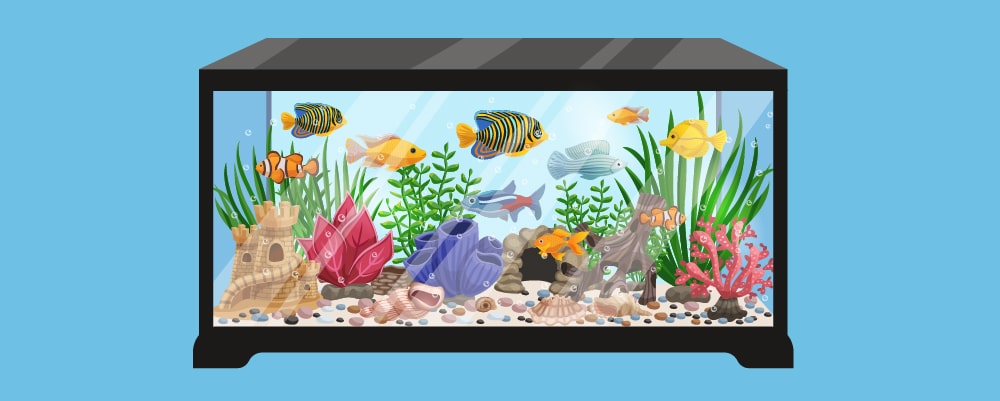
While some of them are better kept with others of their species, others will make excellent (and vibrant) additions to a community tank.
These friendly freshwater fish species can be as colorful and flamboyant as their saltwater counterparts. They are also very hardy and tough creatures that can often be quite easy to care for.
Whether you’re a seasoned expert or a complete beginner in the world of being an aquarium owner, it can be difficult not to get hooked on the freshwater fish and their personalities.
Aside from that, owning an aquarium with lots of beginner-friendly colorful freshwater fish species can offer many health benefits including the lowering of your blood pressure and a stress reduction.
Let’s take a look at 20 home aquarium-friendly freshwater fish species that are great for beginners.
Table of Contents
Freshwater Fish
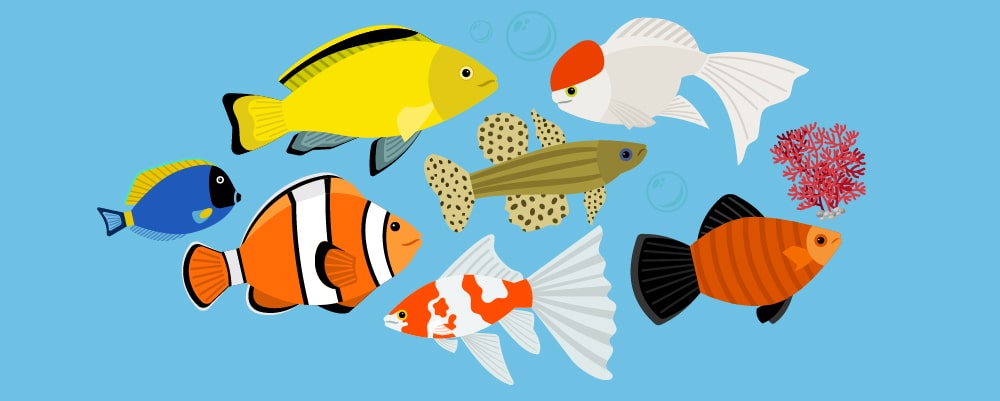
There is a lot of important information to learn about the different types and species of freshwater fish. Here are some of the key health benefits:
Overall Population
Almost half of the overall fish species population is found in freshwater. They inhabit the wetlands, lakes, and rivers that constitute around three percent of the Earth’s total water supply.
There are over 800 well-known freshwater fish species living in North America alone. Yet, globally, the number of fish species exceeds 10,000!
Some freshwater fish species are called anadromous. Two well-known examples of this fish species include trout and salmon. These fish hatch in freshwater, venture out to sea and remain there until they need to return to freshwater to reproduce.
There are other fish species classified as catadromous. These fish, including freshwater eels, do it in reverse: hatch at sea, live their lives in freshwater, and later return to the ocean to reproduce.
Facing Extinction
Although freshwater environments contain many species of fish, their population is steadily declining as time goes on. Almost 20 percent of all known freshwater species are either imperiled or are already extinct.
The reason for the decline in the number of freshwater fish species is largely due to the threats caused by human activities.
Benefits Of Keeping Freshwater Fish
Reduces Stress Levels
You can’t help but feel some joy when you are looking at a thriving home aquarium! There is something innately soothing about watching the fish move around the aquarium space that also works to calm you and everyone around you.
So, if you’ve ever noticed fish tanks in a stressful environment such as a hospital or a corporate office, this should hopefully show you why! Staying on top of your stress levels is vital to ensure that your well-being and overall health are the best they can be.
Spending time around your aquarium will work to keep you calm. You might also benefit from establishing a care routine that allows you to take care of your aquarium.
Helps Lower Blood Pressure
It’s no secret that getting more sleep at a reasonable hour will help your body to function and feel much better than ever before.
If you have a consistent sleep duration and regular bedtime, sleep can provide a whole host of physical benefits such as lowering your blood pressure. This is crucial to your everyday health.
You probably didn’t know that owning and viewing an aquarium display can lower your blood pressure and slow your heart rate at the same time. Not only are they great to look at but they are also extremely useful for keeping you calm and level-headed, all but guaranteeing a lower blood pressure.
Decreases Anxiety Levels
To begin with, fish tanks are an excellent way to provide natural sounds to create a more tranquil atmosphere to help you relax or even fall asleep. The trickling sound of the water performs the same natural function that a sound machine would.
In addition, there are lots of things out there such as aquariums and fish supplies that allow fish keepers to create a stimulating living environment while promoting anxiety and stress relief.
The hypnotic movement of fish swimming back and forth in their tank gives you something to focus all of your attention on. This might help in the limitation of anxious thoughts and actions, and might also be an excellent precursor to an anxiety-free night’s sleep.
Improves Focus And Creativity
In a world shrouded in advancing technologies including the rise of streaming platforms and the importance of social media, it can be hard to disconnect. We do, therefore, sometimes need to shift our focus to reconnecting with elements of nature.
Unplugging from technology can often be a huge challenge, especially if we don’t know how to switch our minds off for long periods. Watching fish swimming around in a tank provides us with the break from technology that we so desperately need and also reconnects us with the natural world.
The best part about owning a fish tank is that you can personalize the tank to include the plants, fish species, and other aquarium supplies that calm you the best. Add colorful pebbles or a scenic backdrop of your choosing.
Calming Effects
We live in a fast-paced and demanding world where it may often feel like we can’t stop to take a full breath of fresh air. This is where it’s necessary to find ways to take a break from the stress that it can cause. Aquarium therapy could prove to be very useful.
Though fish tanks provide lots of visual stimulation to boost focus and inspire creativity, they can also be very calming – especially for children or adults who struggle with behavioral problems.
Taking some time to observe as fish swim around in their tank will ease any muscle tension and also relax and distract the mind from day-to-day stressors.
The physical and mental calming benefits extend far beyond the home and apply to all public aquariums too.
Freshwater Tanks Are Easier To Clean Than Salt Water Tanks
Simply put, Clean are typically much easier to care for than saltwater tanks. Its inhabitants are much more forgiving to the different mistakes made by beginners or new aquarium owners than saltwater tanks.
Freshwater tanks are much easier to maintain and present far fewer risks. They are also much less expensive to maintain than saltwater tanks and environments as the fish inhabiting the space require less complicated set-ups within the aquarium.
20 Home Aquarium Friendly Freshwater Fish Species For Beginners
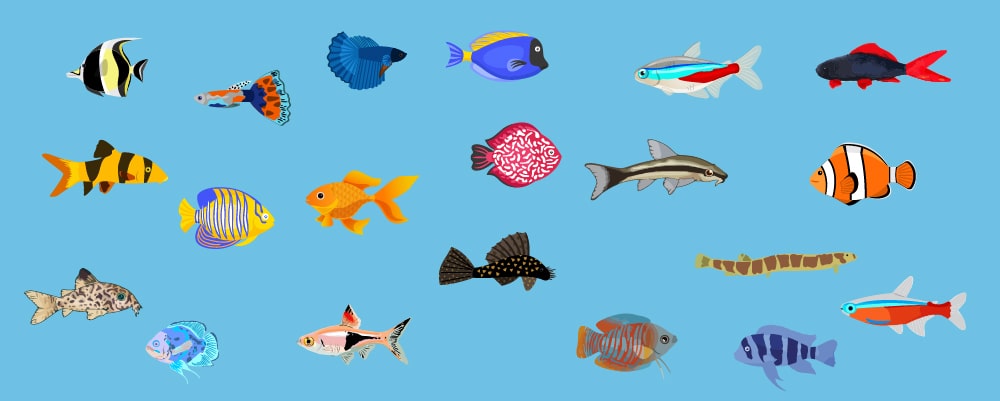
Once you have chosen to begin your freshwater aquarium, selecting your starting fish may feel as exciting as it is daunting. This is because there are many types to choose from!
1. Angelfish

As a member of the South American Cichlid family, freshwater Angelfish are very popular freshwater fish that tend to grow to be around 6 inches long and 8 inches tall.
These fish are aesthetically pleasing and come in many different patterns and colors. They’re most known for their diamond-shaped body and their long trailing fins. Due to their shape, they’re often referred to as the King of the Aquarium.
Angelfish consume other animals such as shrimp and insects and also eat plants. However, they should be kept far away from smaller fish.
Unlike other fish, Angelfish care for their young. However, they can also be quite aggressive and territorial at times. This means they work best in a tank with as few fish as possible.
2. Clown Loach

Part of the Cobitidae family, the Clown Loach is a freshwater fish that is perfectly suited for any home aquarium.
They are vibrantly colored and have an arched dorsal line, with a flat bottom. It is quite difficult to see but these fish have pointed spines that can get caught in netting or prick your finger.
These quirky fish are relatively peaceful and end up at around 12 inches when fully grown. They can grow to be longer in the wild but this is the maximum length they will grow to when in any kind of captivity. Simply, these are not small fish!
A typical Clown Loach can share an environment provided the other species are all non-aggressive. This means you can have many different species with them in the tank.
There are two main types of Clown Loaches from different countries:
- Borneo Clown Loaches that have black fins.
- Sumatran Clown Loaches have bright red fins.
3. Cory Catfish

If you have a smaller home aquarium then the Corydoras might be the freshwater fish for you! These small and peaceful fish are extremely hardy despite their size.
This species is quite shy and will spend a lot of time towards the bottom of the tank throughout the day. They will then come out to feed after sundown.
Appearance-wise, the Cory Catfish comes in various colors including bronze, peppered, green, and panda. A typical variation of this species will end up measuring around 1 to 3 inches long, but this differs depending on the specific type of Cory Catfish you choose to have.
They are often kept in community tanks and get along best with nano fish such as the Tetras or the Rasboras.
4. Betta

If you imagine having a pet fish, you are probably thinking of the Betta species. These exotic-looking fish can be easily identified by their long trailing fins that give off the appearance of a lady’s dress.
Betta cannot breathe underwater as efficiently as other fish species and may need to come up to the surface to get some air quicker than others. This means you must be cautious with cleaning your aquarium.
Betta fish tend to survive in ponds, marshes, slow-moving streams, or other shallow waters. They are relatively low-maintenance fish that are extremely easy to care for and can survive on live foods such as bloodworms, and frozen or dried foods.
One important thing to mention here is that you must only ever have one of these fish in your home aquarium at any given time.
5. Dwarf Gourami
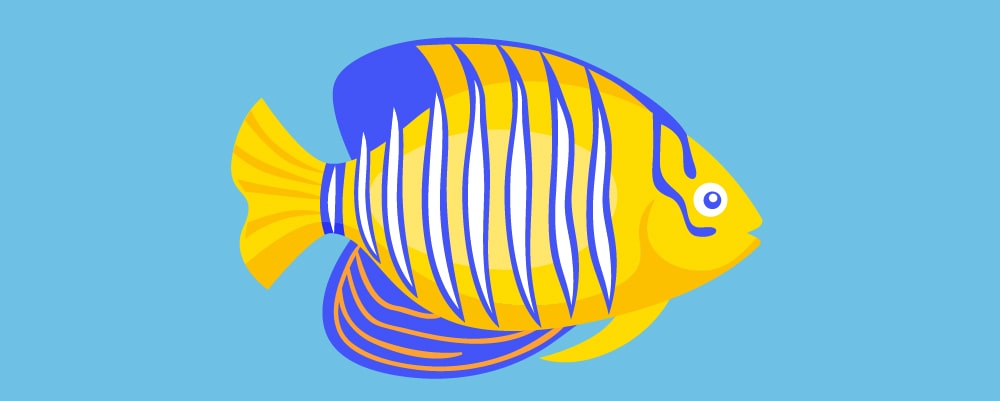
Another great beginner-friendly freshwater fish to have is the small but colorful Dwarf Gourami.
On the whole, the species is very hardy and pretty forgiving of all types of water quality. They get along very well with some of the more peaceful freshwater species out there, making them an excellent addition to any beginner’s community tank.
Dwarf Gourami can be kept in the same home aquarium as others of their kind if they are given enough space. They can be quite territorial with Anabantoids but will generally coexist quite peacefully if there is enough room. The required space varies depending on the species.
These species are omnivores which means they require a varied diet including meat-based foods and algae-based foods. They aren’t typically picky eaters and will accept food in any form.
6. Goldfish

The Goldfish is the most popular type of freshwater pet fish out there. It is a beautiful species that generally grow to around 14 inches when in the wild.
Since the Goldfish rose to popularity in the 19th century, specialized breeding has now given way to many types of fish within the species. Goldfish can come in various colors, sizes, breeds, and shapes but are typically orange. Popular breeds include the Comet Goldfish, the Common Goldfish, and the Fantail.
Goldfish thrive in tanks that are at least 20 gallons and require frequent maintenance including weekly filter and water changes.
Keeping at least two different goldfish in an aquarium at any given time is recommended to promote activity and encourage companionship. They are also extremely easy to look after for beginners.
7. African Cichlid

This colorful species hails from Lake Malawi, Lake Victoria, and Lake Tanganyika. There are many types to choose between including bumblebee cichlids, Kribensis Cichlids, Blue Cichlids, and Peacock Cichlids.
Some of these fish can be boisterous, aggressive, and territorial, meaning they might not be the most suitable fish for beginner fishkeepers. It’s always best to carry out detailed research to ensure you are purchasing the right type of fish.
This species can grow anywhere from 2 to 12 inches in length, and come in several different colors such as green, pink, red, purple, blue, and yellow. Sometimes you can find the African Cichlid with stripes or spots.
You should never mix African and South American cichlids. If you are keeping multiple species in a single aquarium then you must ensure there is adequate room for them to avoid one another.
8. Discus

This is one of the largest and most peaceful South American cichlids. The majority of cichlids can be quite aggressive with their kind, but this particular breed is one of the few that thrives by traveling in a group.
The Discus will typically grow to be around 8 inches long and comes in several color variations including red with a white face, solid red, or red with patches of blue on the anal and dorsal fins. It also shares the title of King of the Aquarium with the Angelfish species.
However, the Discus can be quite difficult to keep at times. They can be quite sensitive to changes in water quality and may end up “bullying” other fish for space and food.
These fish are carnivores and thrive on a varied diet of bloodworms and beef heart, among other things.
9. Guppy

More commonly known as the rainbow fish, Guppies are extraordinarily colored nano fish that come in many captive-bred varieties. They have been a staple part of the aquarium hobby for many generations.
Some Guppies have shorter and more rounded tails, whereas others will have elongated tails that span half of their body length. Simply put, the color and size will vary within this species.
One of the greatest things about Guppies is that they are extremely beginner-friendly fish. They thrive in a community environment and should be kept in groups consisting of around 5 to 10 other fish.
Due to their inclination for social interaction, Guppies will constantly be moving and in view whenever you glance at your home aquarium.
10. Bristlenose Pleco
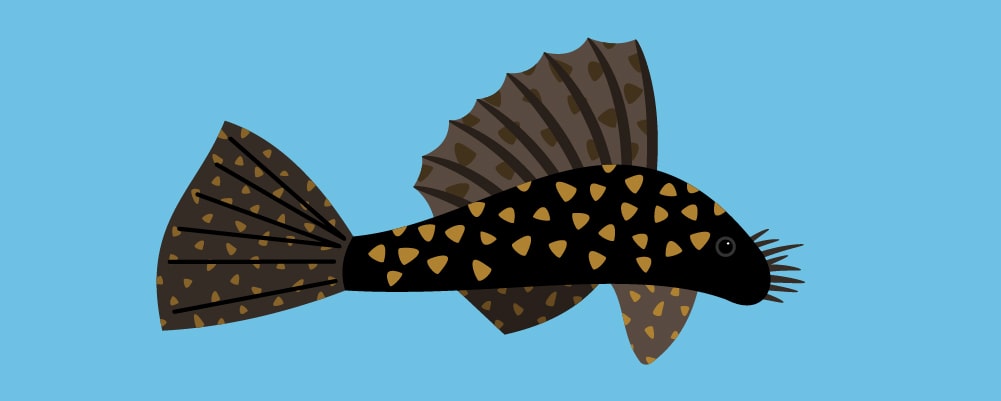
These are particularly popular among beginner fish owners.
If you have ever been watching a Goldfish tank and have noticed a spotty catfish lurking or dwelling at the bottom, you likely have spotted one of these captivating fish species.
The Bristlenose Pleco is best known for its appearance consisting of a brown and flattened body adorned with yellow or white spots, and adorable nose bristles (or tentacles) that develop when the fish has reached full maturity. It is also one of the smallest catfish out there, growing to approximately five inches in length.
They are generally pretty solitary fish, but you can keep two to five Bristlenose Pleco fish together at any given time if the aquarium they are in is large and spacious enough.
As this species are herbivores, it’s best to feed them spirulina wafers or algae a few times a day.
11. Oscar

Oscars generally come in many colors and a variety of patterns. You will most often see them with captivating black and orange coloring that is reminiscent of Halloween, or dark green with colored splotches.
Oscar fish typically grow between 10 and 12 inches long when in captivity. Because of their size, you must make sure they have the correct space to thrive and live a low-stress lifestyle.
It’s also important to note that Oscar fish can be an extremely aggressive and dominant species, and often take over a whole tank if they are given the chance.
While they are alright for beginners if kept by themselves, they will be quite difficult to manage when in a community tank unless you are an experienced aquarist.
12. Harlequin Rasbora
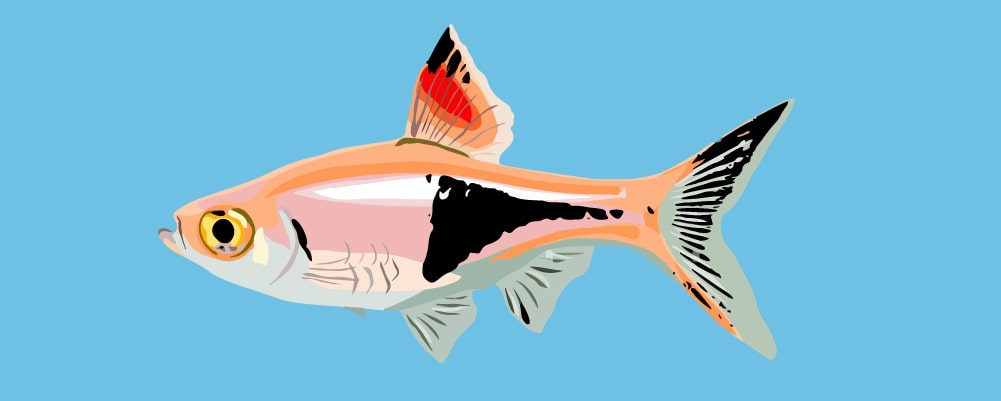
If you’re a beginner looking to set up a home aquarium, you might want to turn your attention to this hardy yet tiny torpedo-shaped fish.
The Harlequin Rasbora is a pretty compact fish that has a standard length of around two inches, meaning it can thrive in smaller-sized aquariums with non-perfect water quality. This makes them the ideal addition to a home aquarium for any beginner aquarist.
In terms of their appearance, you won’t be able to miss these fish as they swim around the tank! They are quite dramatic looking thanks to a distinctive color split between black and a bright red-orange.
Make sure to keep this species in schools of eight to ten individual fish for the most beautiful display. You can keep the Harlequin Rasbora with any fish species provided it is not too large or predatory.
13. Pearl Gourami

If it’s aesthetics you’re after, look no further than the Pearl Gourami! With a stunning iridescent white pearl pattern, they’re truly a sight to behold in any home aquarium.
These are medium-sized Gourami fish (usually somewhere in the region of 4 and 5 inches long) with relatively peaceful personalities. Thanks to their temperament, there is a long list of compatible tank mates.
Like their natural habitat, these fish tend to thrive in freshwater tanks that feature plenty of vegetation and plants. This might prove to be a little costly, but their appearance more than makes up for it!
If you’re planning to choose these friendly freshwater fish for your home aquarium, you will need a tank with a capacity of around 30 gallons or more. If you want to keep a small Gourami school then you should add around 10 to 15 additional gallons for each fish.
14. Convict Cichlid

This freshwater fish (also known as the “zebra cichlid”) is one of the most aggressive types of South American Cichlids out there.
Knowing this information is pivotal, especially if you’re a beginner at maintaining a home aquarium, as their aggressive behavior can sometimes become difficult to manage.
Aptly named due to their black and white prison stripes, convicts can be fiercely territorial of their space and food. This means you must make sure there is enough room for each of these fish to establish their territory.
Because of their distinctive appearance, they have become a staple of the aquarium scene over the last couple of years. This has brought about concerns surrounding overfishing, but the population has yet to be significantly impacted which is good news if you want to keep some of these fish in your aquarium.
They are also omnivores and aren’t too picky when it comes to finding their food.
15. Rainbow Shark

Rainbow Sharks are quite small but incredibly attractive freshwater fish that many people covet. Commonly known as a ruby or red-finned shark, this shark is native to Southeast Asia.
They have seen lots of popularity thanks to their shark-like appearance and their vibrant orange eye-catching fins. But they are also renowned for their strikingly colored bodies ranging from shades of dark blue to black.
Their unique appearance is appealing but they can be quite demanding because of their higher care needs. They can also be quite territorial if other smaller fish are present. Keeping them in a community tank can be risky but they are safe to live with giant danios and larger gouramis, for example.
In an aquarium, Rainbow Sharks will typically eat the algae that naturally forms at the bottom of your tank. Algae can also be given in tablet, flake, or wafer form if there aren’t enough algae inside of your tank for them to consume.
16. Tiger Barb
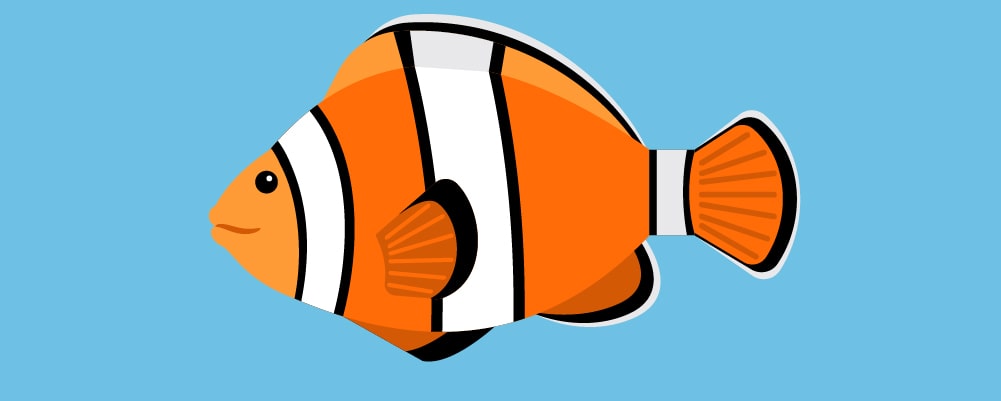
Tiger Barbs are much less inclined to be aggressive and territorial with other fish if they aren’t the first ones in the tank. Specifically, they are known for biting and nipping at the fins of longer-finned fish around them.
As a result, you should add them to an already established tank as this will allow them to settle much easier.
The Tiger Barb is also a delightful-looking fish to watch with a great personality. They possess extremely colorful scales that will only serve to stand out in any type of aquarium. These fish are also best suited for beginners with little to no previous experience with tropical fish.
They also have a tiger stripe pattern but come in a variety of color forms including albino and solid silver. However, they are usually silver with black bands and orange fins.
17. Cardinal Tetra
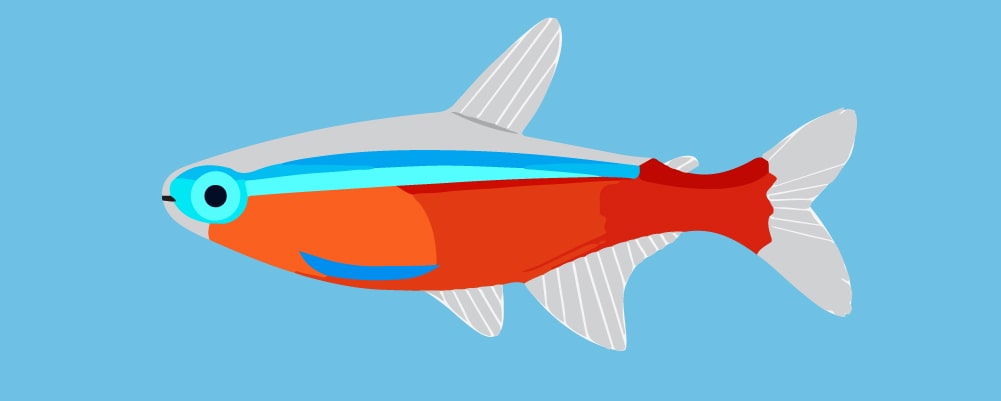
If you’re wanting to add color to your home aquarium, you should look towards the vibrant yet friendly Cardinal Tetra!
These fish are a pretty good choice for beginners because they are quite low maintenance. They are also docile fish and are often at their most energetic and active during the day.
Their body usually reaches between one and two inches in length. Additionally, these beautiful fish typically have a bright red base color contrasted with ice blue lateral lines.
If you’re considering this species for your tank, you should think about adding a school of six to eight of these fish. Group behavior (swimming and feeding) will work as a defense mechanism against large predators.
It’s best to keep the Cardinal Tetra away from any type of fish that shows even the slightest bit of aggression. This is because these species are likely to pick on the delicate Cardinal Tetra.
18. Neon Tetra
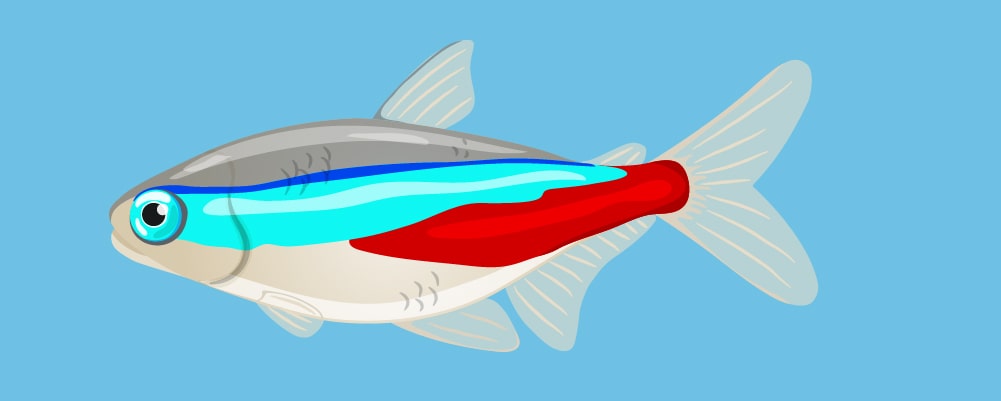
In addition to the Cardinal Tetra, this fish species is another easy-to-care-for nano fish that is highly popular amongst beginners. This is because they are quite easy to care for, and are relatively social fish.
This fish has a slender torpedo-shaped body reaching around an inch and a half in length. But what it lacks in size, it more than makes up for in color.
Neon Tetras are also omnivores which means they will happily consume both animal and plant material.
If you’re a beginner to this species, it’s best to include them alongside other small peaceful community fish. This is because they are tiny and are open to “bullying” or being killed by bigger fish. They get along best with other Tetras, Cory Catfish, and Rasboras.
19. Otocinclus

Generally, Otocinclus are ideal fish for first-time fish keepers.
The Otocinclus (also known as the “dwarf sucker” or “Otos) is a small genus of freshwater catfish that comes from the family Loicariidae. There are around 19 different species of this fish that come in many different colors, patterns, and sizes.
Octocinclus are an excellent alternative to the Pleco if you don’t have the space in your home aquarium for one. Otocinclus fits inside of a 10-gallon aquarium and grows to be around two inches in length.
Like most catfish, Octocinclus are also bottom dwellers. They require a soft substrate that won’t cut their fins and lots of plants and rocks to hide in. And, if your tank has lots of algae, this freshwater fish species will clean it right up!
20. Kuhli Loach

This freshwater fish is one of the greater loaches for nano tanks. Like the larger Clown Loach, the Kuhli Loach is an adorable orange-bodied tiger-striped loach that reaches around five inches in length.
Their slender appearance is both unique and interesting. Coupled with their easy-to-care-for nature, they remain one of the most sought-after freshwater fish in home aquariums for beginner fish keepers and those with lots of experience.
The Kuhli Loach will eat almost anything, meaning they can help in keeping your aquarium clean. These fish are also sensitive to even the slightest changes, meaning you must be cautious about water temperature and quality when introducing a new Kuhli Loach to your aquarium.
They are great additions to community tanks but also thrive when kept with only a few of their kind. As long as they are healthy and have plenty of room to move around, they won’t be difficult to care for!
Summary

These 20 beginner-friendly freshwater fish species are perfect for those new to owning an aquarium. They’re relatively easy to care for and require minimal maintenance.
Before you make any investments, you must ensure that you know the relevant information to properly care for your fish. This includes daily feeding and frequent cleaning of the water within the tank. Doing this will help you to learn more about your chosen fish and their personalities. Over time, you will soon grow to adore your freshwater fish!
No related posts.
